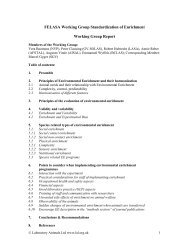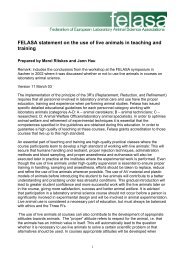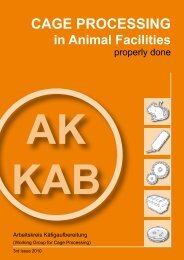CAGE PROCESSING in Animal Facilities - Felasa
CAGE PROCESSING in Animal Facilities - Felasa
CAGE PROCESSING in Animal Facilities - Felasa
- No tags were found...
You also want an ePaper? Increase the reach of your titles
YUMPU automatically turns print PDFs into web optimized ePapers that Google loves.
Wash<strong>in</strong>gHot water mixed with detergent (alkal<strong>in</strong>e, pH neutral, or acid) is sprayed from a tank via jets onto the itemsto be washed. In cage and rack washers the detergent solution (also called detergent liquor) is collected <strong>in</strong> atank beneath the chamber where it is pumped back <strong>in</strong>to the wash<strong>in</strong>g tank. In cab<strong>in</strong>et and tunnel washers thewater is collected <strong>in</strong> the wash<strong>in</strong>g tank placed underneath, where it is recirculated. Thus, the items can be sprayedwith a high volume flow of water and detergent solution, mak<strong>in</strong>g additional fresh water unnecessary dur<strong>in</strong>gthe wash<strong>in</strong>g phase.Where required, it is possible to perform a series of wash<strong>in</strong>gs, with for example alkal<strong>in</strong>e and acid detergents.Therefore the washer must be equipped with several wash<strong>in</strong>g-tanks. Usually, the wash<strong>in</strong>g water solution is largelyrecirculated for the follow<strong>in</strong>g loads to reduce the water consumption as much as possible. Approximately4 - 7 percent of water is newly added.To reduce the amount of water needed to r<strong>in</strong>se off the items, it might be helpful <strong>in</strong> cab<strong>in</strong>et washers and cageand rack washers to wait for the detergent solution to drip off first.Neutralis<strong>in</strong>gTo ensure there are no residues left, an item washed with alkal<strong>in</strong>e detergents requires neutralisation. This canbe achieved either by an immediate neutralisation step prior to the r<strong>in</strong>s<strong>in</strong>g process or trough us<strong>in</strong>g an acidr<strong>in</strong>se aid for the r<strong>in</strong>s<strong>in</strong>g process. Neutralis<strong>in</strong>g is particularly important for polycarbonate (PC) cages <strong>in</strong> order toprevent the material from be<strong>in</strong>g damaged by alkal<strong>in</strong>e residues <strong>in</strong> the steam sterilisation process.R<strong>in</strong>s<strong>in</strong>gResidual detergent is removed with clear hot water that is sprayed via jets on the washer load. A r<strong>in</strong>se aid(also acid r<strong>in</strong>ser for neutralisation) can be added. To avoid lime scale or salt deposits it is recommended touse dem<strong>in</strong>eralised water. Polysulfone (PSU) requires material-specific r<strong>in</strong>se aids.Detergent solution should not be mixed with r<strong>in</strong>s<strong>in</strong>g water.Dry<strong>in</strong>gThe purpose of the dry<strong>in</strong>g process is to dry the items to an acceptable residual moisture.With suitable r<strong>in</strong>se aids, added dur<strong>in</strong>g the r<strong>in</strong>s<strong>in</strong>g process, the items can dry faster after be<strong>in</strong>g removed fromthe chamber.In tunnel washers, the items are usually dried <strong>in</strong> a dry<strong>in</strong>g zone with hot air. This is a cont<strong>in</strong>uous process. Theresult<strong>in</strong>g vapours should be exhausted through <strong>in</strong>tegrated extraction hoods at the entry and exit area of thetunnel as well as <strong>in</strong> the r<strong>in</strong>s<strong>in</strong>g zone. This central exhaust process can be comb<strong>in</strong>ed with a heat recovery.With cage and rack washers, hot-air can be used for the dry<strong>in</strong>g process. The aeration of the chamber removesthe residual moisture from the load. In wash cycle-type mach<strong>in</strong>es, the dry<strong>in</strong>g can further be enhanced by feed<strong>in</strong>gclean steam <strong>in</strong>to the chamber.For bottle washers, added r<strong>in</strong>se aid or a subsequent hot-air dry<strong>in</strong>g is not necessary, as, usually after wash<strong>in</strong>g,water bottles are refilled with dr<strong>in</strong>k<strong>in</strong>g water.Unload<strong>in</strong>gUnload<strong>in</strong>g <strong>in</strong> case of cab<strong>in</strong>et, rack, and bottle washers means that the load<strong>in</strong>g trolleys or racks are removedfrom the chamber and cleared of the items. In case of tunnel washers (or if applicable of semi- or fully automaticbottle washer), of course, the belt is cleared. While unload<strong>in</strong>g, a f<strong>in</strong>al dry<strong>in</strong>g outside the mach<strong>in</strong>e beg<strong>in</strong>s.F<strong>in</strong>al dry<strong>in</strong>g outside the mach<strong>in</strong>eStored heat <strong>in</strong> the washed items helps potential residual moisture to evaporate (dry<strong>in</strong>g by specific heat). Thisrequires a sufficient heat<strong>in</strong>g of the items while be<strong>in</strong>g r<strong>in</strong>sed or dried <strong>in</strong>side the mach<strong>in</strong>e. Where necessary, provisionsshould be made to prevent the operat<strong>in</strong>g staff from gett<strong>in</strong>g burnt by the specific material heat (e.g. sett<strong>in</strong>gup a f<strong>in</strong>al dry<strong>in</strong>g zone with warn<strong>in</strong>g notices; def<strong>in</strong><strong>in</strong>g a m<strong>in</strong>imum cool<strong>in</strong>g time for a safe handl<strong>in</strong>g of items).Cage Process<strong>in</strong>g <strong>in</strong> <strong>Animal</strong> <strong>Facilities</strong> · 4th issue · 2013 21






